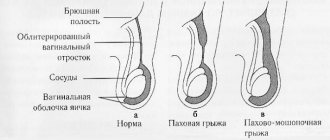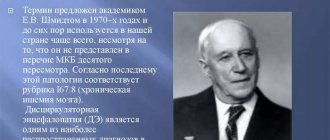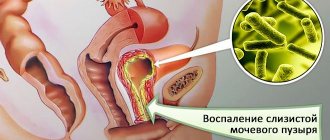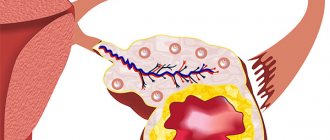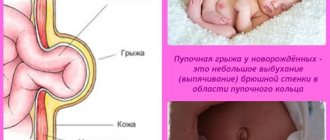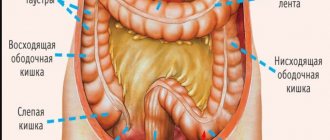Umbilical hernia is a pathology in which part of a person’s internal organs begins to extend beyond the anterior abdominal wall.
Most often, part of the small or large intestine and the greater omentum (gastrointestinal ligament) extend beyond the peritoneum - an anatomical formation of a lamellar structure located in a healthy person between the stomach and the transverse colon. But in addition to the intestines and greater omentum, other organs of the abdominal cavity and even the small pelvis (for example, the bladder) can also extend beyond the peritoneum.
Umbilical hernias occur anywhere in the abdominal cavity within 2 - 3 cm from the center of the navel. Organs can prolapse directly through the navel (umbilical ring) or through a gap near the umbilical canal - first into the subcutaneous tissue, and only then into the umbilical ring. The prolapsed organs end up in a thin film of connective tissue - the hernial sac. Prolapsed organs can be located freely in the hernial sac or form an adhesion with it - a single structure.
Among hernias of the anterior abdominal wall, about 12% of cases are umbilical hernias. At the same time, women experience umbilical hernia more often than men.
In recent years, medicine has made significant advances in diagnosis and surgical treatment. If the pathology is detected in a timely manner, treatment is carried out according to plan, then the probability of relapse (re-formation of a hernia) does not exceed 1%.
What it is
An umbilical hernia (hernia umbilicalis) is the protrusion of internal organs through defects in the abdominal wall in the navel area. In newborns, it occurs due to disturbances in the process of closure of the umbilical ring during the healing of the umbilical wound.
Like any hernia, it has three components:
- hernial orifice;
- hernial sac;
- hernial contents.
In this case, a wide or deformed umbilical ring serves as a way for the abdominal organs to exit. The omentum or intestines protrude through it, ending up directly under the skin, being wrapped in peritoneum and transverse fascia.
Here's what it looks like in the photo in reality:
An umbilical hernia in newborns develops more often in the first two months of a baby’s life, being a congenital pathology. However, the disease can manifest itself at a later date (up to a year).
Diagnosing the disease at any age is not difficult, although for parents a hernia looks scary. As a rule, examination is enough to make a diagnosis. Sometimes ultrasound, general clinical tests and other studies may be needed to promptly identify complications of this disease.
All the deadlines have passed - the hernia has not gone away...
The baby has entered his second year, but the protruding navel remains. For an umbilical hernia in a 2-year-old child, treatment by a surgeon is still not required if:
- it does not increase in size;
- does not hurt and adjusts on its own;
- does not cause digestive disorders or the general condition of the child.
The only exceptions are the already mentioned trunk-shaped hernias. They almost never heal on their own, so the baby will have to be operated on within a year, or at most two years: there can be no “humane” options here.
With a small hernia that does not have a tendency to grow or incarcerate, you can continue to live peacefully, limiting yourself only to following medical advice on strengthening the abdominal wall. Another thing is large protrusions: with a large (more than 1.5 cm) umbilical hernia in children 3 years old, treatment can only be surgical.
The same applies to even older children. Doctors say that if the hernia has not disappeared by three years, then the likelihood of its disappearance even with regular conservative treatment is extremely low.
No matter how sorry you feel for the baby, for a large umbilical hernia in children 5 years of age and older, only radical treatment can be offered. Five years of age is the deadline: you simply can’t wait any longer.
Causes
An umbilical hernia in infants appears due to the anatomical features of this area. The fact is that the lower part of the umbilical ring is denser than the upper, since it is formed during the obliteration of blood vessels, being replaced by strong connecting structures.
On top, almost the entire space of the umbilical cord is occupied by adipose tissue, which during the formation of the scar becomes its weak point. Failure of connective and muscle fibers in the peri-umbilical zone leads to disruption of the formation of a normal tight closure of the umbilical ring.
For reference! Often, weakness of certain anatomical structures is inherited. Therefore, if mom or dad had an umbilical hernia in childhood, there is a very high probability of developing the same pathology in their descendants.
Embryogenesis also plays an important role. It has been proven that alcohol abuse, smoking, taking certain medications and substances, and infectious diseases during pregnancy lead to underdevelopment of connective and muscle tissue in the unborn child.
The presence of a defect in the area of the umbilical ring does not always manifest itself as a hernia. With a small size of the hernial orifice, the pathology can proceed secretly and independently for a long time, disappearing without treatment by 2–3 years. But this rarely happens.
Usually even small hernias make themselves known. Parents can see a protrusion on the anterior abdominal wall, emanating from the umbilical area. This happens when intra-abdominal pressure increases.
Factors that provoke the release of formation are the following:
- severe, prolonged, annoying crying or coughing;
- indigestion (flatulence, colic, constipation);
- throwing a small child up;
- early adoption of a vertical position (the baby began to sit and walk early).
Parents can eliminate or prevent all of the above reasons. If your child constantly cries a lot, you should take him to the pediatrician. If a persistent cough occurs, the baby should be given special drops or syrup. Digestive problems are solved by the nursing mother following a diet if the baby drinks breast milk, and by selecting formula for bottle-fed children.
Well-known doctors, in particular Dr. Komarovsky, have already said many times that there is no need to rush to put a child on his feet. The child must sit down and stand up on his own. However, even in physically underdeveloped children who lead a sedentary lifestyle, the chance of a hernia increases.
Important! Until the baby is 9 months old, you need to trust nature. Everything will happen naturally. First, the child will crawl and sit, and only then will stand on his own legs and take his first steps. During this time, the muscles of his tummy will become stronger and will be able to easily withstand the increase in internal pressure.
Infants with a lack of vitamin D (rickets) and diseases characterized by damage to the connective tissue and muscles of the whole body will have an increased risk of developing an umbilical hernia.
This also applies to babies born before 37 weeks, since all their systems and organs are not fully formed. Parents of such children need to be especially vigilant.
Until now, on the Internet you can find a version that an umbilical hernia in newborns occurs due to improper cutting of the umbilical cord in the maternity hospital. This opinion is wrong. The technique of cutting and tying the umbilical cord cannot in any way affect the anatomical features of the umbilical ring. A hernia can appear regardless of
the type of navel in children .
Symptoms and treatment of umbilical hernia in adults
The first and most obvious sign of how to recognize the disease will be a protrusion in the navel area of various sizes: from a pea to a chicken egg.
If the process is not complicated by strangulation and the internal organs protrude freely through the entrance hernial orifice, in the lying position the formation will decrease in size or disappear altogether.
When straining, coughing, laughing, crying, defecating, the protrusion reappears in its original place.
Abdominal pain of varying intensity is another symptom that often worries patients. The intensity of pain can be moderate, insignificant, or increasing, unbearable.
If an irreducible hernia develops, intestinal obstruction, coprostasis, ischemic or necrotic changes in the wall of the organ strangulated in the umbilical ring are formed.
In pregnant women, the expansion of the umbilical ring is often a harbinger of pathology. It can be detected by an excessive increase in the diameter of the navel, its stretching and some bulging.
If the hernia has not yet formed, gynecologists and surgeons recommend that such women wear a bandage, which serves as a kind of support for the abdominal muscles and an additional fixation.
Significant symptoms indicating a hernial strangulation that require immediate medical attention include:
- Formation of a dense, painful, irreducible bulging formation in the navel area;
- Increasing intensity of abdominal pain up to unbearable;
- The appearance of nausea, vomiting;
- Increasing symptoms of intoxication: increased body temperature, weakness, sweating.
Symptoms
The main symptom is the presence of a formation in the navel area. Depending on the size, it may look like a small bump or a voluminous bulge. In most cases, the diameter of such a ball will be 2–3 cm.
A pathological tubercle will appear in situations where intra-abdominal pressure increases (crying, constipation, etc.).
d.) and disappear at rest, on an empty stomach and during sleep.
The characteristics of education are as follows:
- a bulge from 5 mm to 5–6 cm or more, round or oval, less often - irregular in shape, which protrudes from the navel;
- soft to the touch;
- painless;
- the skin in the navel area is not changed;
- under the formation a wide umbilical ring can be felt, which is a hernial orifice;
- with a large lump, the skin becomes stretched and thinner, as a result of which intestinal peristalsis can be observed;
- easy to put inside with a characteristic squelching sound;
- comes back when intra-abdominal pressure increases.
Many parents are interested in questions: does an umbilical hernia hurt, is the child’s anxiety and digestive problems related to it, what are the risks of strangulation, and what will happen to it in the future.
Doctors assure that if the course is uncomplicated, this pathology does not cause inconvenience to the baby. An exception may be the situation when the hernia sticks out. Then the child will be able to touch her with his hands, showing interest in her and the associated anxiety.
You can hear the phrase from grandmothers: “ The child cried a lot and often started screaming, so he screamed for a hernia .” This statement is incorrect, as is the fact that this disease causes intestinal colic and flatulence. More often, unpleasant symptoms are associated with improper feeding of the child. As a rule, the baby's intestines adapt over time and signs of intestinal discomfort go away.
A protrusion on the anterior abdominal wall is a cosmetic defect, and many mothers and fathers try in every possible way to get rid of it. However, it should be understood that excessive efforts and the use of some traditional methods can lead to complications.
Clinical picture and possible complications
Characteristic signs of the disease are:
- Abdominal pain;
- A protrusion in the navel area that disappears with pressure (with an unstrangulated hernia);
- Expansion of the entrance gate - the umbilical ring;
- Nausea (sometimes).
The prolapse of contents through the ring of the anterior abdominal wall (intestinal loops, parts of the omentum) can increase with physical exertion, coughing, and therefore the bulge in the umbilical region increases.
In small children, when lying on their back, the formation may disappear, but when crying, sucking, or moving, it appears again.
The severity of the clinical symptoms of this pathology depends on the size of the hernia, the presence or absence of its complications.
Dangerous complications are:
- Incarceration of the contents of the hernial sac (intestinal loops or omentum)
- Inflammation of the umbilical membranes
- Rupture of the membranes, their purulent melting
- Formation of intestinal fistulas
These are life-threatening conditions that can lead to the development of acute intestinal obstruction or peritonitis.
What is the danger of the disease
Like any other, an umbilical hernia can lead to emergency surgery. This situation, according to doctors, happens extremely rarely, but every parent must know what a strangulated hernia looks like and be able to recognize its signs.
How to determine infringement - the following symptoms will tell you, even at the initial stage of the process:
- the hernia looks tense, full, motionlessly fixed in the umbilical ring, the skin over it is thinned, its color is changed;
- upon palpation, the compaction is sharply painful and inactive;
- the child will scream from severe abdominal pain, he may twist during a painful attack;
- severe dyspeptic disorders appeared (vomiting, bloating due to non-excretion of gases, etc.);
- body temperature has increased, there are signs of intoxication.
Important! In the event of a strangulated hernia, it is impossible to try to force the contents of the hernial sac into the abdominal cavity, since these actions will only aggravate the situation.
Any delay with such a clinical picture can become a tragedy. Indeed, when strangulated, the intestinal loops located in the hernial sac are clamped by the umbilical ring, and the required amount of blood stops flowing to them. The processes of tissue necrosis begin. Feces contribute to the rapid development of the inflammatory process. Perforation of the hernia is possible.
Tissue necrosis occurs rapidly. The extent of the surgical intervention performed and the prognosis depend on how soon a sick child is taken to the hospital. All dead tissue (parts of organs) will have to be cut out. If the operation is not performed in time, gangrene will begin.
To prevent an emergency, parents need to closely monitor the hernia. If it gradually increases in size, periodically does not straighten well, its release is accompanied by anxiety in the child, you should not wait for the disease to develop, you should urgently consult a doctor.
Alarming symptoms are constant constipation and failure to pass gas, the appearance of mucus and blood in the stool, systematic nausea and abdominal pain.
With improper care and non-compliance with hygiene measures, a hernia can be complicated by the development of an infectious process. Large formations often lead to chronic constipation (even coprostasis) and inflammatory bowel diseases.
Reducible and irreducible umbilical hernia - what is the difference
The main difference between these conditions is that with reducible protrusion of the internal organs, they can be carefully and effortlessly returned to the abdominal cavity by lightly pressing on the hernial sac.
Irreversible hernias are characterized by either incarceration of intestinal loops or omentum sections that have prolapsed into the umbilical ring, or the formation of an adhesive process.
This is a dangerous condition that disrupts the work and functioning of internal organs and requires immediate surgical intervention.
Irreversible protrusions are a rare occurrence in children of the first year of life. As a rule, their disease does not occur with this type of complication, but it cannot be completely excluded.
Every parent should be aware of the signs of a strangulated hernia, and also understand that if these signs appear, the child should be immediately hospitalized.
Treatment at home
Small umbilical hernias (up to 3 cm) go away on their own when the child reaches three years of age. Doctors say that no active action is required to cure them. However, with large formations, for the purpose of prevention and to reassure parents, pediatricians give recommendations for conservative treatment.
It must be comprehensive, systematic and long-term. The plan of therapeutic measures is selected by the doctor. If the baby’s family members agree to strictly follow the doctor’s instructions, the treatment process begins.
Popular methods of dealing with umbilical hernia include:
Bandage (belt, corset)
The special bandage BG-101D and other children's models are used in combination and with the progression of pathology. You should not purchase the product yourself; it should be chosen by a doctor. The doctor explains to parents how to use the bandage correctly.
The bandage belt allows you to securely fix the hernial sac inside the abdominal cavity, equalizing internal and external pressure. It performs the following functions:
- prevents internal organs from coming out;
- has a weak compression effect in the umbilical area;
- is a kind of corset for the muscles of the abdominal wall;
- prevents hernia strangulation.
The device is used as an independent method of treatment, and in the pre- and postoperative period. Externally, the product looks like a wide belt with fastenings. It is made of hypoallergenic material.
However, if the baby experiences an allergic reaction when using it, the treatment is canceled.
You should not wear a bandage in case of complicated hernias or in the presence of skin diseases at the site of fixation.
The doctor decides how long to wear the bandage belt. The doctor must also correct the umbilical hernia before using the device for the first time. Parents can then do this. The scheme for putting on the bandage is as follows:
- put the baby on his tummy for a few minutes to let the gas go away;
- carefully examine the baby’s skin on the back and stomach, assess the condition of the hernia - the skin everywhere should be clean and dry;
- lay the belt on a hard surface;
- place the child on it with its back down;
- carefully straighten the hernial contents and fasten the belt, making sure that the belt is located exactly in the navel area (one parent can help the other by holding the baby);
- wear the device no more than 12–16 hours a day, removing it at night.
As a rule, after two months of wearing a bandage, small hernias successfully regress. This treatment method is optimal and safe in most cases.
Patch
You can buy an umbilical hernia patch at a regular pharmacy. The contraindications for it are the same as for the bandage. The doctor must direct the hernial contents into the abdominal cavity before the first gluing. He trains parents.
The patch can then be removed at home. However, if the sealing is done incorrectly, the risk of complications is very high, so it is still recommended to entrust the replacement procedure to a specialist.
In Soviet times, an ordinary adhesive plaster was used, which often caused unwanted local reactions.
Nowadays modern hypoallergenic products have appeared.
The most popular is the Porofix patch, which is made of waterproof material, which allows you to bathe your child without removing it. The navel must be sealed for 10 days, then replaced. The duration of the course is determined by the doctor. If any skin manifestations appear in the area where the product is applied, it must be immediately removed and treatment discontinued.
Taping
Kinesio taping has gained particular popularity recently. It is used to treat many diseases of the musculoskeletal system. However, pediatricians recommend refraining from gluing tapes to infants.
Scientific studies have not been conducted to confirm the safety and effectiveness of this method. Applying tapes to the umbilical area is dangerous.
Massage
Massage, like gymnastics, is, in principle, recommended for all infants. However, you need to massage a child with an umbilical hernia correctly, otherwise the effect may be negative. In order not to harm the baby, it is enough for the mother to learn how to perform simple actions by watching how a specialist does it.
First, perform circular stroking movements on the tummy (strictly clockwise, along the loops of the large intestine), then counter stroking, then pinching around the navel.
The massage is combined with placing the baby on his tummy and turning him on his side. This allows you to strengthen not only the rectus muscles, but also the oblique muscles of the anterior abdominal wall. Typically, massage procedures are done in the evening, after bathing, when the baby is as relaxed as possible.
Strengthening poses (laying on the stomach)
This is the simplest and most obvious way to strengthen your abdominal muscles. Each time before feeding the baby should be placed on the tummy. It should lie there for 10–15 minutes. Naturally, the hernial contents should be in the abdominal cavity.
Exercise therapy (gymnastics)
Young children should perform physical therapy under the supervision of professionals. An anti-hernia set of exercises is aimed at strengthening and improving blood circulation in the anterior abdominal wall. This includes:
- encouragement of turning over and twisting legs in the air;
- squatting with adult support;
- exercise on a fitball, etc.
The older the child, the more varied the activities will be. Exercise therapy is carried out only in fixing devices (bandage, regular plaster).
Copper nickel
Since ancient times, people have had a method of attaching a five-ruble coin to the navel (sometimes they use a ruble or a kopeck). Modern medicine has proven that this ancient method of treatment with copper is not only useless, but also dangerous. By resorting to such “treatment”, parents expose their baby to a huge risk of developing navel omphalitis (inflammation of the navel) and other serious consequences. Therefore, no manipulations with placing a nickel on the navel should be done.
An important place in modern medicine is given to the prevention of hernias:
- Massage provides a good effect for the prevention of hernias of all ages. Vacuum massage with cups and honey massage are especially effective.
- Body weight control. Maintaining proper nutrition means limiting high-calorie foods.
- Special prevention methods have been developed for young children. If a child was born weak and has a risk of developing hernias, doctors recommend that parents teach the baby the so-called reflex crawling. The baby is placed on his tummy. A hand is placed under the child's feet. When a child rests his feet on his arm and tries to crawl, ideal natural conditions are created for the prevention of umbilical hernias.
- Physical therapy is indicated directly for the prevention of hernias in adults and children over three years of age and adults. The emphasis is on exercises aimed at strengthening the rectus and oblique abdominal muscles. Raising the pelvis, turning the body, turning the legs to the sides (in a lying position) are especially effective.
The main thing is not to overdo it. Remember: exercise is only good as a preventative measure. When the hernia has already made itself felt, then, for example, pumping the press can even be dangerous.
Is surgery necessary?
According to the observations of pediatric surgeons, small umbilical hernias are prone to self-healing. In three-year-old children, the tissues of the umbilical ring gradually become stronger, losing their elasticity, and the defect closes. However, if the disease does not go away by the age of 5, then there is no chance of self-healing. In this case, surgical tactics involve planned surgical treatment.
The optimal age for umbilical hernia surgery is 5–7 years. At this age, the baby's tissues are pliable and quickly recover, forming a healthy umbilical ring. Adolescents may experience certain difficulties during surgery.
Emergency operations are carried out strictly according to indications. Surgeons will agree to operate on huge hernias that are prone to complications only after the baby reaches 6 months. The decision to undergo surgery is always made based on the doctor's opinion.
Classification
Based on their origin, there are two types of hernia:
- congenital;
- acquired.
If reduction is possible, the following types of hernias are distinguished:
- Irreversible. The protrusion inside the umbilical ring cannot be reduced. This is due to the development of the adhesive process, as a result of which the hernia fuses with the hernial opening. This is an advanced form of hernia, which can lead to the development of severe complications and poses a danger to the patient’s life.
- Reducible. When the patient assumes a horizontal position, the hernia disappears. This type of hernia is observed in the initial stages of the disease and can be easily corrected.
How is the operation performed?
Planned hernia repair is performed in a hospital under general anesthesia. The operation lasts 20–30 minutes. The surgeon reduces the hernial contents and sutures the hernial orifice; special meshes are not used in children.
There are several types of operations, which mainly differ in access, but their essence is the same. Previously, they used the same technique as in adults, according to Dyakonov - Mayo - Sapezhko. The Lexer method or the Spitz operation are possible. In the latter case, the postoperative suture will have a semi-oval shape.
Lexer method
Mayo method
Sapezhko method
Also, laparoscopy is now increasingly being performed, lasers and new minimally invasive, highly effective techniques are being used. The scar after such interventions is almost invisible (even if the hernia was large), and the patient can be discharged from the hospital earlier. However, such operations are performed for a fee.
Complications
The main complication of a hernia in adults is its strangulation. Strangulation of a hernia can lead to gangrene of the hernial sac and adhesive intestinal obstruction. A sign of strangulation of an umbilical hernia is sudden pain in the area of the hernial protrusion; the hernia also suddenly stops being reduced.
- Intestinal obstruction often occurs. What to do in case of strangulation:
- Call a doctor immediately.
- Take a warm bath and try to repair the hernia in the water.
- If the adjustment fails, lie on your back with your legs tucked under you and wait for the doctor.
- If the pain is severe, put ice on the navel area.
- If you feel nauseous, swallow a piece of ice.
- Try not to take painkillers, and under no circumstances use laxatives.
- If the ambulance is delayed, you can give an enema of warm water.
If the umbilical hernia is large and old, then adhesions can form in it, and inflammation of the organs located in the hernial sac can occur. Therefore, the main task is to prevent the hernia from growing. Folk methods and exercises will help with this.
Postoperative period
After the baby wakes up from anesthesia, but not earlier than 12 hours after the operation, he can be given water. The liquid should be drunk in small sips.
A day later, when intestinal motility appears, the child can be offered broth (or light soup), jelly, kefir, compote and baked apple. On days 2–3, the menu is expanded by adding porridge, fruit puree and yogurt. Over the next 24 hours, the baby is gradually fed his usual foods.
From the first day, if the child actively moves and sits up, a postoperative bandage should be worn on the stomach. The baby should not leave the bed for the first 24 hours.
In the next two days, a gentle hospital regime is observed, that is, jumping, sudden movements, etc. are excluded. The bandage is used for at least 2-3 weeks. You can walk and move freely at home in it.
After 3-4 weeks, the recovery will be over, and the child will be able to begin living as usual. However, in the future it is better to refrain from excessive physical activity, in particular from physical education. No special rehabilitation is required after standard hernia repair in children.
Reviews of rupfix umbilical plates
1. They do not cause allergies, they come off easily in the bathroom, they help. They are too big for a newborn, but can be cut. The umbilical hernia appeared in the baby's month. Umbilical correctors helped a lot along with massage and gymnastics
https://otzovik.com/review_7121669.html
2. Good afternoon! My daughter has an umbilical hernia that is not very large. The usual patch did not help (they used it for already... six months!!). I ordered Arilis (in 10 days the hernia decreased by half its size, but not completely)... so I still didn’t understand what its secret was)) I glued the usual one on the same principle).
https://otzovik.com/review_5424071.html
3. The child has a very large hernia, I’ve already bought the patch twice, it’s much better, but the hernia hasn’t completely gone away yet. I will take it again. Satisfied with the quality.
https://www.blagomed.ru/prod/korrektor-dlya-pupka-arilis-4510.html
Traditional methods of treatment
In addition to the above-mentioned copper nickel, young parents can hear the following advice from the older generation:
- to gnaw with teeth;
- give the child a rhubarb decoction;
- smear the umbilical area with butter and propolis at night;
- tie fern leaves;
- apply compresses with whey;
- wipe with cotton wool soaked in diluted vinegar;
- other methods (spells, homeopathy, etc.).
There are websites of so-called healers on the Internet, where they describe in detail how, in their opinion, an umbilical hernia in newborns should be treated. They provide photos of cured patients. Sometimes parents, not trusting doctors who say that the hernia will go away on its own, turn to charlatans. The cost of their services is high, but the effect is zero.
It should be understood that folk imagination is limitless, and these methods have no scientific basis, so they should be avoided. Often, due to such dubious procedures, when they talk, put a nickel and use other dubious methods, the newborn ends up in the hospital.
Important! Trust your child's health only to professionals. Any treatment method must be approved by a doctor.
Treatment with folk remedies
There are many traditional medicine recipes that are used for umbilical hernia. Of course, they do not replace surgical intervention, but they can be used along with wearing a bandage, in preparation for surgery and in the period after surgery to prevent relapses.
Propolis compress
. 1 tbsp. l. pour 200 ml of dried propolis. alcohol Leave for 7 days, shaking the contents daily. When the tincture is ready, take 100 grams of homemade butter, melted in a water bath, and 2 tbsp. propolis tinctures. From the resulting substance, make a warm compress on the area of the umbilical hernia and around it. Make sure that the contents of the compress do not get into the navel. After the compress is absorbed into the skin, wipe it with cold water.
Sea buckthorn oil
. Rub sea buckthorn oil into the area of the umbilical hernia. This must be done carefully so as not to damage the hernial sac. The number of procedures is twice a day, morning and evening, the number of days is unlimited. The umbilical hernia should strengthen and not progress.
Horsetail and hernia grass
. Brew these herbs with boiling water and drink as tea to treat umbilical hernias. Course of treatment: drink one herb for 2 weeks, then another for 2 weeks.
Clover decoction
. 1 tbsp. Pour a glass of boiling water over chopped clover grass. Strain the infusion an hour after brewing. Take a third of a glass three times a day before meals.
Oak liqueurs
. Make a tincture of young branches, leaves and acorns of oak with red wine in free proportion. Afterwards, apply warm compresses to the area of the umbilical hernia. The course of treatment is 2-3 months in adults; when treating children, consult your doctor.
nettle leaves
. Collect fresh nettle leaves, wash and chop. Mix the crushed leaves with rich sour cream. Make a compress by covering it with polyethylene on top. The course of treatment is unlimited.
Silver cinquefoil
. Take 1 tbsp. l. chopped cinquefoil, pour a glass of boiling water. Leave until cool, strain. Take a quarter glass 4 times a day.
Prevention
Parents often ask doctors why this pathology occurs and how to prevent it. Prevention should begin with pregnancy planning. The expectant mother is obliged to prevent any negative impact on the fetus during pregnancy.
If a child has already been born with an umbilical hernia, the main task of the parents is to prevent the progression of the disease. To do this you should:
- exclude situations where the baby is forced to cry for a long time and hysterically;
- get rid of digestive problems (eliminate constipation, remove gases, follow a diet for a nursing mother, etc.);
- do not throw the baby up, do not sit him down, do not put him on his feet prematurely;
- prevent and promptly treat diseases the main symptom of which is cough;
- do not overuse swaddling that is too tight;
- prevent rickets (take vitamin D;
- from 2 weeks of age, gradually begin to strengthen the abdominal muscles (massage, swimming, special poses and exercises).
Here's what Dr. Komarovsky recommends regarding umbilical hernia:
To avoid complications, you should carry out hygiene procedures daily and promptly detect the slightest changes in the navel area. Any information should be obtained from your doctor.
Diagnosis of the disease
Diagnosis of this pathology is not very difficult and is based on the characteristic clinical picture, laboratory and instrumental examination methods.
If a child or an adult experiences a characteristic protrusion in the navel area that decreases in volume in a horizontal position, pain in the abdomen, or nausea, you should consult a surgeon. The doctor will prescribe:
- X-ray of the abdominal cavity, stomach and duodenum;
- FGDS;
- Ultrasound of hernia formation;
- Herniography is a research method based on the introduction of a contrast agent and a subsequent series of x-rays.
The doctor’s task is to establish the correct diagnosis and identify concomitant diseases of the gastrointestinal tract. The tactics for treating the pathology depend on the patient’s age, the size of the hernia defect, and the presence or absence of complications.
According to the doctor's indications, a laparoscopic examination can be performed for diagnostic purposes, which combines not only diagnosis, but sometimes treatment.
Laparoscopy refers to minimally invasive surgical interventions using special video devices inserted through punctures in the anterior abdominal wall under anesthesia.
Thanks to this research method, it is possible to visualize on the monitor screen the entire “picture” that occurs in the abdominal cavity, perform the necessary medical manipulations, and even eliminate the hernia defect.
Answers to frequently asked questions
Can a hernia go away without surgery?
Yes, as a rule, an umbilical hernia in newborns heals on its own by the age of 3 years.
Can a hernia appear a year after birth?
An umbilical hernia in newborns usually manifests itself in the first two months of life, but in isolated cases it can also appear in a one-year-old child.
Can a hernia burst?
An umbilical hernia in a newborn cannot burst on its own. Its perforation is possible due to tissue necrosis or trauma.
How to help an umbilical hernia?
Ninety-nine percent of umbilical hernias up to half a centimeter in size will close on their own. Hernias larger than three centimeters are also often closed. And at the same time, you can help them. We are talking about sealing the hernia with a plaster. It is very important to use an “umbilical patch” product specially designed for this purpose, since a regular patch causes serious irritation to the child’s skin. Allergy, infection and even inflammation - this is the list of consequences of using a “regular” patch. The umbilical patch is hypoallergenic and - in addition to its auxiliary effect in the fight against hernia - preserves the health of the skin and the comfort of the baby's life.
Kinds
The violation may be:
- Innate. It is detected during the first month after the baby is born. Most often, weakened, premature children suffer. In such babies, the umbilical ring closes much later than in healthy babies.
- Acquired. It can occur at any age under the influence of provoking factors, such as strong screaming, constipation, and flatulence. The risk of developing pathology increases with weakness of the umbilical ring.
Treatment
Photo: netdna-ssl.com
Only surgical intervention will bring complete relief from an umbilical hernia.
At the preparatory stage before surgery, it is recommended to wear a special bandage, which, when the hernia is reduced, does not allow it to protrude. It is imperative to follow recommendations that eliminate the main provoking factor – increased intra-abdominal pressure. For constipation, take laxatives, avoid physical activity, avoid overeating, and prevent coughing if you have chronic diseases.
When treating an umbilical hernia, surgical intervention consists of two stages: hernia repair, when the parietal peritoneum is excised, forming a hernial sac, and hernia repair, in which the hernial orifice is closed. There are two types of hernia repair: tension and non-tension.
Tension repair uses tissue surrounding the hernial orifice and non-absorbable threads. Tension-free plastic surgery involves the use of tissue from other parts of the body, or synthetic prostheses in the form of meshes. The latter method is currently the most popular, since the mesh grows well with connective tissue, forming a strong capsule, and the postoperative wound heals faster and causes less discomfort to the patient.
Depending on the layer of the abdominal stack into which the mesh prosthesis is installed, operations are divided into:
- Onlay – the prosthesis is sutured under the skin over the muscle layer;
- Inlay - the prosthesis is sewn into the muscle layer at the level of the hernial orifice;
- Sublay - the prosthesis is sutured inside the abdominal cavity under the hernial orifice and covered with the parietal peritoneum;
- IPOM – placing the prosthesis from the inside of the abdominal cavity on the parietal peritoneum. This method allows laparoscopic surgery to be performed without opening the abdominal cavity;
- Combined method - involves the use of the patient’s own tissues along the edge of the hernial orifice, but reinforced with a prosthesis, to suturing the defect.
In children, the same treatment tactics are used, but with minor nuances. They try not to take newborns and children under five years of age for surgery, only if there is a threat of serious complications. An umbilical hernia usually resolves on its own by age 2-3 as the child becomes more active with age, causing the abdominal muscles to become stronger, which helps the umbilical ring narrow and close. Therapeutic gymnastics and massage also help with this, which parents can independently do to the child after the first month. Laying the child on his stomach 10-16 minutes before meals has a very good effect on muscle tone, which also leads to a speedy recovery. For older children, wearing a brace and exercising in a swimming pool may be recommended.
Provoking factors
An umbilical hernia in infants can appear for a variety of reasons, but the most common is an anatomical predisposition, that is, the problem lies in the fact that the umbilical ring does not close completely or it happens quite slowly. A decrease in muscle tone due to some long-term illness is also important. Prematurity, which we have already mentioned, also plays an important role.
At the same time, some young parents continue to believe that an umbilical hernia in a child is caused by an increase in intra-abdominal pressure. This is facilitated by:
- prolonged screaming or crying of crumbs;
- problems with the intestines (dysfunctional processes, increased gas formation, difficulty emptying);
- vomit;
- coughing.
In fact, none of these factors is a trigger for the formation of hernias.
Does it hurt?
One of the most common issues worrying young mothers is the likelihood of pain due to the development of a hernia.
It should be noted that umbilical hernia in most cases does not bother children . In other words, it does not cause pain. The disease may not bother the child at all.
The baby may experience discomfort when internal organs that exceed acceptable limits are pinched by muscles.
Hernia patch for newborns
Please note that you only need to purchase special patches intended for the treatment and prevention of hernia. Now there are several varieties of such patches in pharmacies. The most effective are Hartmann, Porofix, Cosmopore E and Chicco. They usually don't look like regular patches, but come in two parts. When one part is inserted into another, a contraction is made and a fold is formed, which presses the navel inward.
Please note that such patches are allowed to be used only after the umbilical wound has completely healed.
Hernia patch
Rehabilitation after surgery
- Usually, if the operation goes without complications, the patient is allowed to get up on the first day.
- In the postoperative period, wearing a special bandage is recommended (about a month when using mesh implants).
- On days 10-14, you can start doing therapeutic exercises, but you are prohibited from performing abdominal exercises.
- After the operation, daily dressings are performed, the sutures are removed on the 7th day (if they do not dissolve on their own).
- For pain, painkillers are prescribed.
- The doctor may also prescribe antibiotics, vitamins, and immunomodulators.
At first, a special diet is indicated; the bark is based on gentle nutrition. You need to eat small portions and often. All foods that can cause bloating and constipation are excluded to avoid increasing intra-abdominal pressure.
How to talk about a hernia in a baby yourself?
Our grandmothers believed that it was no coincidence that the baby had a hernia. It's all because of evil spirits. Therefore, conspiracies were used to treat the disease.
Conspiracies for a hernia in a baby:
The mother needs to bite the baby’s hernia in the morning and say:
“Hernia, hernia, I’m gnawing on you, you have one tooth, I have seven, and I’ll eat you.”
And so three times. After each pronunciation, you must spit over your left shoulder
Another conspiracy:
“Go, hernia, to a clean field, gnaw the bitter aspen (say three times), gnaw it off, but don’t gnaw the baby, hernia, the baby of God (baby’s name) and don’t gnaw it off.”
Conspiracy for hernia
What happens if an umbilical hernia is not treated? Is it dangerous?
Umbilical hernia in children is a pathology that requires regular consultations with a surgeon, even if hospitalization and surgical intervention are not required at the moment. Children over 4-5 years old need special attention.
Despite the fact that the formation does not cause discomfort, some complications may develop, such as:
- strangulation of the hernia, which contributes to the occurrence of the inflammatory process;
- inflammation inside the hernia itself;
- intestinal obstruction due to accumulated feces.
